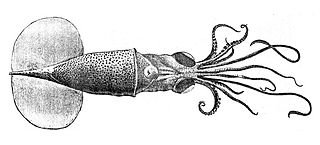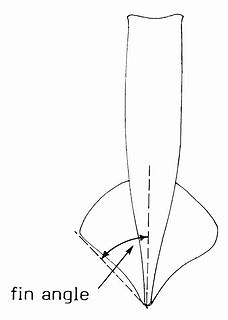This page is based on this
Wikipedia article Text is available under the
CC BY-SA 4.0 license; additional terms may apply.
Images, videos and audio are available under their respective licenses.

Loliginidae, commonly known as pencil squids, is an aquatic family of squid classified in the order Myopsida.

The Enoploteuthidea are a family of squid comprising approximately 40 species in four genera. Most species have a mantle length ranging from 3–13 cm. Hooks are present on all arms and tentacles. The family is best known for the large array of photophores throughout the body.

The Gonatidae, also known as armhook squid, are a family of moderately sized squid. The family contains about 19 species in three genera, widely distributed and plentiful in cold boreal waters of the Pacific Ocean. At least one species is known from Antarctic waters, and two from the North Atlantic. The genus Eogonatus was created for the species known as Eogonatus tinro because it did not have hooks on the tentacular club and it has 5 rows of teeth on the radula. Molecular studies in allozymes and mitochondrial DNA have indicated that this species nests within the genus Gonatus, although other authorities treat it as a synonym of Gonatopsis okutanii.

The hooked squid, family Onychoteuthidae, currently comprise about 20–25 species, in six or seven genera. They range in mature mantle length from 7 cm to a suggested length of 2 m for the largest member, Onykia robusta. The family is characterised by the presence of hooks only on the tentacular clubs, a simple, straight, funnel–mantle locking apparatus, and a 'step' inside the jaw angle of the lower beak. With the exception of the Arctic Ocean, the family is found worldwide.

Abralia is a genus of squid comprising around 20 species from the family Enoploteuthidae. They are small squid which can be found in the epipelagic to mesopelagic zones while some species are found in water with shallow substrates on steep slopes on the boundary of the mesopelagic zone. They are distinguished from other members of the Enoploteuthidae by not normally having large, black photophores at the tips of arms IV, although if these are present they are not covered in black chromatophores, and having fins which extend beyond their tail. The photophores of the integument are characteristicand are found in the three types. "Lensed" photophores are a blue color with a white ring, "simple" photophores are small and violet-colored and the "complex" photophores are surrounded by small green satellite points and have a green centre. The complex photophores will frequently appear to be blue depending on their physiological state. The integument also has small black chromatophores which look like dots. They have 5-12 variably sized photophores on the eye. Either the right or left arm IV is hectocotylized.

Heteroteuthidinae is a subfamily of bobtail squid encompassing five genera and around ten species.
Idiosepius picteti is a species of bobtail squid native to the Indo-Pacific waters off eastern Indonesia.

Chiroteuthis veranii, commonly known as the long-armed squid, is a species of chiroteuthid squid. It grows to a mantle length of 12.5 cm and a total length of 130 cm.

Asperoteuthis is a genus of chiroteuthid squid comprising four species:

Abraliopsis is a genus of squid in the family Enoploteuthidae comprising 11 nominal species. Species are characterised by the presence of photophores on arm pair IV. Suckers are absent from this arm. The type species is Abraliopsis hoylei.

Planctoteuthis is a genus of chiroteuthid squid comprising five species, occurring worldwide in lower mesopelagic to bathypelagic depths in tropical to temperate waters. It has been suggested that members of Planctoteuthis are neotenic, retaining characteristics of the doratopsis developmental stage. This is marked in the retention of the paralarval tentacular club, unique among subadult chiroteuthids. Members lack both photophores and a funnel valve. The genus was originally placed within the monotypic family Valbyteuthidae, under the name Valbyteuthis. Similarities between the paralavae of Valbyteuthis and Chiroteuthis led to its inclusion in the family Chiroteuthidae. Eventually, Valbyteuthis was incorporated as a junior synonym of Plantoteuthis, citing previous descriptions of the paralarvae.

Counter-illumination is a method of active camouflage seen in marine animals such as firefly squid and midshipman fish, and in military prototypes, producing light to match their backgrounds in both brightness and wavelength.

Abralia veranyi is a species of squid in the family Enoploteuthidae. Common names include the eye-flash squid, Verany's enope squid and the midwater squid. It is found in the Atlantic Ocean and the Mediterranean Sea. It undergoes a daily vertical migration from deep waters to near the surface.

Cephalopod fins, sometimes known as wings, are paired flap-like locomotory appendages. They are found in ten-limbed cephalopods as well as in the eight-limbed cirrate octopuses and vampire squid. Many extinct cephalopod groups also possessed fins. Nautiluses and the more familiar incirrate octopuses lack swimming fins. An extreme development of the cephalopod fin is seen in the bigfin squid of the family Magnapinnidae.
Long-armed squid may refer to various long-limbed squid of the suborder Oegopsina:

Uroteuthis is a genus of 14 species of common inshore squids of the Indo-West Pacific and is further subdivided into 3 subgenera. The members of the Uroteuthis genus are the only squids of the Loliginidae family that possess photophores and all species in the genus have a pair of photophore organs on the ventral surface of their ink sac either side of their intestine.
Lolliguncula is a genus of squid from the family Loliginidae from the eastern Pacific and western Atlantic, known as brief squid. The genus is divided into two subgenera Lolliguncula and Loliolopsis. They are rather small squids with a maximum mantle length of 120mm, that inhabit shallow warm seas, although some species have been recorded in areas of low salinity. They are typified by having a short mantle, which is round at the posterior; and fins that are broader than long, but which have no posterior lobes. The males produce spermatophores with a long cement body and they lack a ventral crest on their hectocotylus. Their suckers have square teeth which ring the entire margin or are placed distally. The males do not have enlarged suckers on the left ventral arm. The tentacular club is expanded and contains suckers in four series. The two subgenera differ in the morphology of the hectocotylus.















